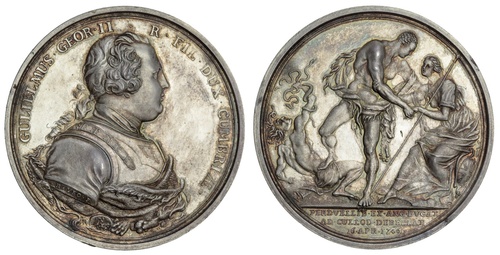
Auction: 22007 - British and World Coins and Commemorative Medals Autumn Auction
Lot: 805
Battle of Culloden, AR Medal, 1746, by R. Yeo, GULIELMUS • GEOR • II • R • FIL • DUX • CUMBRIAE •, armoured and draped bust right, rev. Britannia seated left, is assisted by the Duke, as Hercules, who tramples upon Discord, PERDVELLIB • EX • ANG • FVGAT AD • CULLOD • DEBELLAT 16 • APR • 1746 • in exergue in three lines, plain edge, 51mm, 50.35g (Eimer 604; MI ii 613/278; Woolf 55:2; Harding 64 this medal), some small pin marks to the obverse and a die flaw to exergue, otherwise with brilliant surfaces and lightly cabinet toned, almost as struck and most attractive in hand
In 1740, Frederick II, (later the Great), ascended the throne of Prussia after the death of his father, later the same year the Hapsburg Emperor Charles VI also died leaving his huge territories to his daughter, Maria Theresa. Frederick, who had a powerful army and was not averse to using it, attacked and seized Silesia, an Austrian province adjacent to his own territory. George II began to fear for the safety of his own German possessions. An alliance between Prussia, France and Spain would have threatened the stability of Europe. In anticipation of this threat, Britain formed an alliance with Austria and renewed its traditional arrangements with Holland. By early 1743, and in the face of great opposition at home, a British army 30,000 strong was on the Continent led by the King himself and his son the Duke of Cumberland. Victories were secured at Dettingen and Fontenoy but in October 1745, British forces were withdrawn to meet the threat posed by the Young Pretender, 'Bonnie Prince Charlie', who sought to seize the advantage offered by the emerging war on the Continent.
That year, with very little by the way of preparation or planning, he sailed from Nantes with a handful of supporters and landed in the Western Isles. He could be sure of support only in the Highlands where the clansmen had not benefited from the Union of England and Scotland and where they continued to live a life notable for its lawlessness which terrified their neighbours. Prince Charles' standard was raised at Glenfinnan by Lord George Murray but attracted only 1,200 men. Nevertheless, the rebels marched southwards and routed an army two and a half times its own size at Prestonpans. Most of Scotland was ruled by Prince Charles by the end of September when he crossed the border with England and captured Carlisle, Penrith, Lancaster and Preston. Lord Murray had skilfully drawn Cumberland away from the London road and the Capital lay open to attack. The City was in a panic but the march southwards had attracted very few new adherents and the Jacobite force was insufficient to attempt a bold attack against the capital. At Derby, in December, the order for retreat was given. Lord George Murray managed a withdrawal with great skill, turning and mauling the English on a number of occasions, particularly at Falkirk, but Cumberland concentrated his forces and forced the issue with great brutality at Culloden.
The battle of Culloden brought to an end any realistic hopes of a Stuart succession and effectively signalled the end of the commemorative medal as a significant weapon of military, political and religious propaganda in Britain.
Subject to 20% VAT on Buyer’s Premium. For more information please view Terms and Conditions for Buyers.
Sold for
£1,500
Starting price
£700




